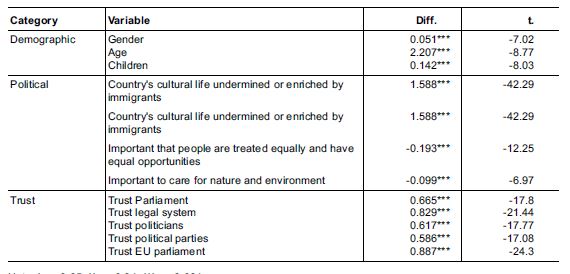Introduction
Some of the social and political dynamics that were perceived as enduring and immovable in Western societies have recently changed and continue to change. The economic crises that hit the world in 2007 caused a deep and persistent worsening of citizens’ living condition, especially within western democracies. Among other factors, income inequality and unemployment harshly increased; the job market undergone through an exceptional worsening registering wages stagnation, an increase of precarious jobs and a decrease of workers’ purchasing power. At the same time, in most of western countries social mobility dramatically dropped (Archibugi & Cellini, 2018). The COVID-19 pandemic is worsening the picture.
The combination of these factors, according to the literature, contributed to the spread of citizens’ frustration and the drop in their trust in democratic institutions (Dotti Sani & Magistro, 2016; Foster & Frieden, 2017). In this context, a populist upsurge has been registered among all western democracies with populist parties and movements gaining consensus and, in some cases, governmental appointments. Populist parties and movements that emerged in the last decades are often based on certain rhetoric advocating for the superiority of national identities and the necessity of closing national borders to preserve national traditions and to come back to the splendor of an idealized past. Most of the established political parties, media, and academics often tend to identify populist voters as merely less educated and ignorant citizens, but is this characterization correct and fully explaining the phenomenon? Who populist voters are? Do they have common characteristics? Are they united by common identities? And if it is so, what are the identities and belongings they share, and which are more associated with the populist vote? The present paper seeks to answer these questions by tracing a profile of populist voters within European Union countries, identifying their characteristics, and assessing whether there are identities’ traits able to explain populist support. To do so, it analyses the data provided by the European Social Survey that, besides identifying respondents’ parties voted, allow to isolate different identity and belonging characteristics.
The paper is organized as follows: the next section presents an overview of the literature related to the concepts of populism, identity, and political identity. Sections “Methodology”and “Results” present the analytical strategy employed, describing the data used in the quantitative analysis and the results obtained. Finally, section “Discussion and Conclusions” concludes the paper by discussing the outcomes and their implications.
Theoretical Framework
There is not a shared definition of what populism is, and this label is applied to different parties and movements. In general terms, populism highlights a form of political identity that calls into question the nature of the actions of a community associated with a political party, underlying the need to rethink the linkage between citizens and politics by contrasting the elite. In this respect, several authors define the term populism (and populist) applying it to political groups and individuals who make appeals to “the people” in contrast to “the elite” (McDonnell & Cabrera, 2019; Mudde & Rovira Kaltwasser, 2013, 2017); Albertazzi and McDonnell (2008) define populism as an ideology that juxtaposes the virtuous and homogeneous people against a set of dangerous elites trying to steal the sovereign people of their rights; therefore, as pointed out by Mudde and Rovira Kaltwasser (2017), populism “involves a critique of the establishment and an adulation of the common people” (p. 5); Arditi (2005) defined populism as a “drunken guest at a dinner party” (pp. 90-91), assuming that populism usually it’s seen as a dangerous guest in a democracy, underlining the entire legitimation process of those in power. For these reasons, populism is characterized by contradictions, starting with the fact that it articulates anti-party discourse, but resorts to party form itself, or that it calls for popular participation but that it secures it by simply garnering support for personalized forms of leadership.
Without entering into the academic discussion on the definition of populism, which is not the focus of the present work, it is useful to stress that, according to the international literature, populits common denominator is represented by the belief in the existence of a monolithic and virtuous people, the distrust in the elites that are thought to be corrupt, and the consequent distrust in established political parties and institutions that in populists’ view are the expression of such corrupt elites.
For the purpose of the present paper, however, it is fundamental to delimit what populism is and what is not and, for this reason, we chose to employ the definition of populist parties provided by The PopuList project. The Project (Rooduijn et al., 2019), starting from the definition provided by Mudde (2004), defines populist parties as:
parties that endorse the set of ideas that society is ultimately separated into two homogeneous and antagonistic groups, “the pure people” versus “the corrupt elite,” and which argues that politics should be an expression of the volonté générale (general will) of the people. (Mudde, 2004, as cited in Rooduijn et al., 2019, para. 7)
To be able to outline the identity characteristics of populist voters, a definition of the concept of identity is also needed. Looking at its etymology, the word “identity” is connected to the adjective idem (same, identical) that has a double interpretation: on the one hand, it refers to the concept of uniqueness, to all those characteristics capable of qualifying a specific individual by distinguishing him and making him recognizable from others; on the other hand, it refers to the notion of identification, that is the tendency to identify an individual with those who are believed to be similar, thus emphasizing the contribution of the community to the definition of the Self. Since the beginning, the concept of identity has been one of the central issues of the social sciences both from a micro- and a macro-sociological point of view: indeed, over the decades, the notion of identity or, to better say, the process of the construction of identity has been an object of theoretical reflection by numerous scholars, whether they are related to the so-called structuralist approach (see Parsons, 1951) or to the interactionist and/or ethnomethodological one (see Blumer, 1969; Garfinkel, 1967; Mead, 1934; Simmel, 1950). In this sense, the paradigm of identity belonging can be viewed as the basis for both personal self-identification and relationships between individuals, groups, and communities. So, identity is built in the multiple interactions among individuals in which forms of mutual recognition are realized, supporting the construction of networks and dynamics that often can also lead to discriminatory practices. In the words of Jenkins (1996):
social identity is our understanding of who we are and of who other people are, and, reciprocally, other people’s understanding of themselves and of others (which includes us). Social identity is, therefore, no more essential than meaning; it too is the product of agreement and disagreement, it too is negotiable. (p. 5)
Hence, this also means that the concept of identity concerns how the individual considers and constructs himself as a member of certain social groups such as nation, social class, cultural level, ethnicity, gender, profession, and so on.
In this respect, identity politics differs from the standard sociological definition of identity above mentioned, since the former focuses on the persistence of the same characteristics that identify an individual. Erikson (1968) conceptualized the modern notion of national identity as a social category; Fearon (1999) defines it as a set of persons marked by a label and distinguished by rules deciding membership and (alleged) characteristic features or attributes. So, the notion of identity politics, as well as the traditional notion of identity, are socially constructed and they vary over time and space depending on the social and historical context.
Indeed, identity politics is based on promises to protect the “silent majority” from the harmful consequences of globalization, as well as the European identity and integration and the constant growing immigration. According to Müller (2016), populism is a form of identity politics that combines the anti-establishment rhetoric with a conviction that only populists should be legitimate to represent the civil society, “the people”, as they hold a superior national spirit. In this sense, identity politics focused on ascriptive characteristics, such as race, origins, and religion. Indeed, as Noury and Roland (2020) stated: populist radical right parties are usually Eurosceptic parties and resort to nativism, which combines nationalism and xenophobia and feeds on the feeling that EU integration and mass migration, as well as mechanisms of multiculturalism, threaten ethnic or national identity (see, e.g., also Rooduijn, 2019). In addition to this, Mudde (2007) proposed a minimal definition of identity politics, also called the “ideational” approach, defying populism as a:
thin-centered ideology that considers society to be ultimately separated into two homogeneous and antagonistic groups, “the pure people” versus the “corrupt elite”, and which argues that politics should be an expression of the volonté générale (general will) of the people. (Mudde, 2007, p. 23)
Furthermore, as sustained by Viviani (2017) populism presents different degrees of intensity and it belongs to the several different identities of the modern leadership which represent our hyper-fragmented society and also highlights groups that are more disadvantaged relative to others and through them, populism promotes national identity. By way of example, the economic situation and the consequent economic anxiety (precariousness and uncertainty about the future) raise the receptivity of the messages coming from populist parties, mostly centered on the cultural backlash and the perception of the existence of an “us” and of “the others”. Political phenomena as the Brexit referendum in the UK or the election of Trump in the USA, both in the same year (2016) as well as the cultural movements for the rejection of globalization and the less tolerance toward immigrants, have been labeled ad populist movements, even if they seem to be more closely to nativism (mostly the right populism), but it is also strictly connected to the concept of identity politics (Mudde & Rovira Kaltwasser, 2017; Rooduijn, 2019).
Methodology
To assess populist voters’ characteristics and answer to our research question, namely, to what extent populist voters share common identity traits and common characteristics compared with non-populist voters, we employed a quantitative approach by analyzing individual micro-data of a pool of citizens from 29 European countries.
Data have been retrieved from the ninth round of the European Social Survey (ESS), carried out in 2018. The ESS is a biannual survey, carried out within the European Union countries, which enquire respondents about a variety of aspects, including but not limited to merely demographic questions, questions related to socio-political attitudes, up to questions regarding individual wellbeing and human values.
Among the political aspects, the survey enquired respondents about their political preferences by asking them which political party they voted for in the last national, local or European election. We, therefore, coded populist voters based on the party voted in the last election in their countries.
As we already pointed out, the definition of what populism is and what are the aspects and characteristics that classify a party as populist are still contended issues within the academic debate. Since the definition of the populist phenomenon goes much beyond the scope of the present work, to code populist parties, as already pointed out, we chose to adopt the definition of populist parties provided by The PopuList project, according to which populist parties are those:
parties that endorse the set of ideas that society is ultimately separated into two homogeneous and antagonistic groups, “the pure people” versus “the corrupt elite,” and which argues that politics should be an expression of the volonté générale (general will) of the people. (Mudde, 2004, as cited in Rooduijn et al., 2019, para. 7)
According to this definition, the PopuList classifies political parties of 31 European countries. The complete list of the populist parties, by country, included in the analysis is presented in Table 1.
Table 1 List of populist parties included in the sample and their positioning on the left-right scale
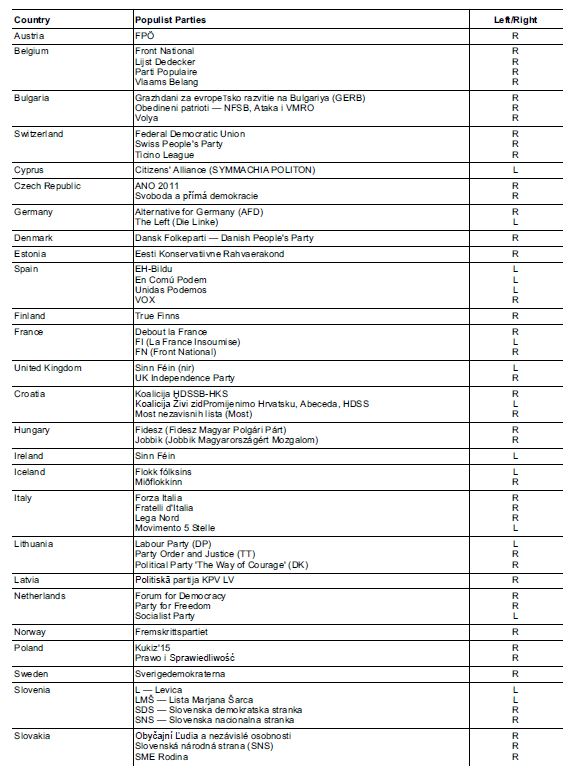
Source: Authors’ elaboration.
Once respondents that have not voted for the last elections available have been eliminated, the resulting sample comprises 33,088 respondents. From these, all the respondents that refused to disclose the party for which they voted have been dropped. The resulting sample that has been the focus of our analysis comprises 27,539 individuals from 27 European countries. Figure 1 graphically reports the total number of voters, the number of populist voters, and their corresponding share.
As shown by Figure 1, populist parties within countries varies consistenlty in terms of electoral weight. Data show that their share among respondents varies from 70% in Italy to 0% in Portugal.
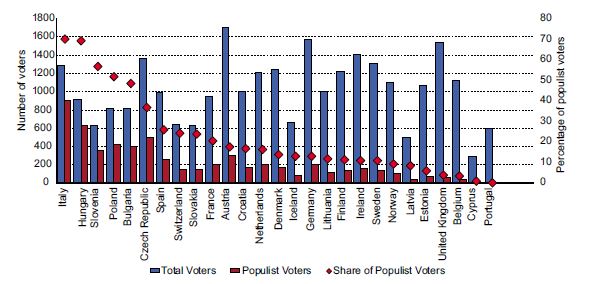
Source: Authors’ elaboration on ESS data.
Figure 1 Total number of voters, and numberand share of populist voters bycountries
From the ESS several relevant variables have been selected. Variables selected have been then classified according to seven categories:
Demographic;
Economic;
Social values;
Political;
Trust;
Perceptions.
Respondents who voted in the last election and that disclosed the party voted have been coded as populist voters and non-populist voters. Average and percentage values have been calculated for the total of voters and compared with those of populist and non-populist voters.
To assess the presence of statistically significant differences between the two groups, depending on the type of variable, two samples t-tests the equality of means (Welch, 1947), and two-samples Kolmogorov-Smirnov tests of equality of distributions (Kolmogorov, 1933; Smirnov, 1933) have been performed. The results of all the tests performed are reported in Table 2 and Table 3.
Table 2 Report of the results of the two-samples Kolmogorov-Smirnov tests of equalityof distributions
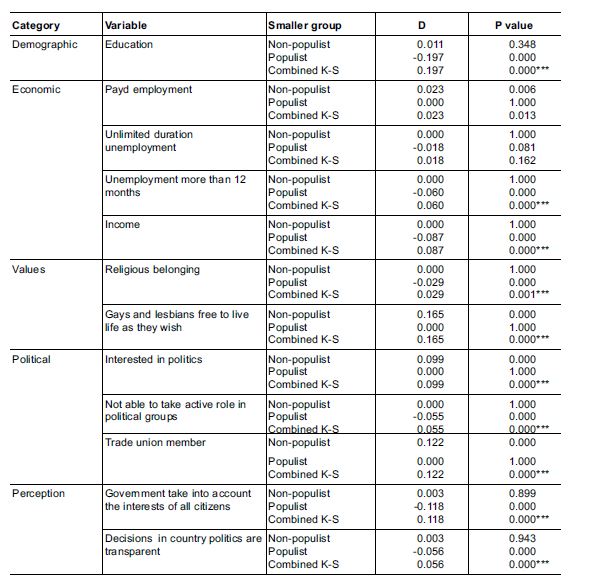
Source: Authors’ elaboration. Note: * p< 0.05, ** p< 0.01, *** p< 0.001
Results
Before moving to the core analysis of the profile of populist voters, it is important to note that, in addition to varying in terms of electoral weight, populist parties also varies witihn countries in terms of their positioning in the left-right political spectrum. Table 4 reports the total number of populist parties, the number of left-wing and right-wing populist parties, and their share of voters within the countries considered.
Table 4 Total number of populist parties, number of left-wing and right-wing populist parties, and their share of voters within the countries considered
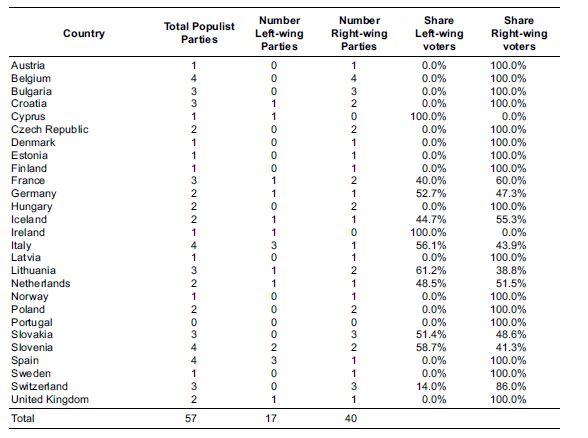
Source: Authors’ elaboration on ESS data.
Data show how the analysis considers a total of 57 populist parties. Among the countries considered, the number varies from 0 in Portugal to 4 in Italy, Slovenia and Spain. Out of the 57 total populist parties considered, 40 are positioned in the right side of the political spectrum while the minority, 17, are positioned in the left side. Witihin 15 out of 27 countries considered, populist parties are represented by right-wing parties only, while within 2 countris, Cyprus and Ireland, populist parties are represented only by left-wing parties.
Made this importat premise, to outline the profile of populist voters we firstly analyzed their demographic characteristics. From this analysis emerged that populist voters represented respectively by 51.4% of men and 48.6% of women, while among both total voters and non-populist voters the share of women is higher than that of men. Compared to total and non-populist voters that on average are respectively 54.2 and 54.7 years old, populist voters are on average younger, showing an average age of 52 years. Also, populist voters on average report a lower number of children than total and non-populist voters, respectively 2.06, 2.16, and 2.2. Lastly, the share of non-populist voters’ that hold a tertiary education degree almost double that of populist voters, respectively 32.3% and 17.3%.
For all the three variables, the differences between populist and non-populist voters resulted to be statistically significant even if, with the exception of the share of voters holding a tertiary education degree, quite modest.
Moving to the second category, namely that of socio-economic characteristics, Figure 2 presents data about having a paid employment, having a fixed-term employment contract, ever being unemployed for more than one year and the income level of total voters and populist and non-populist voters.
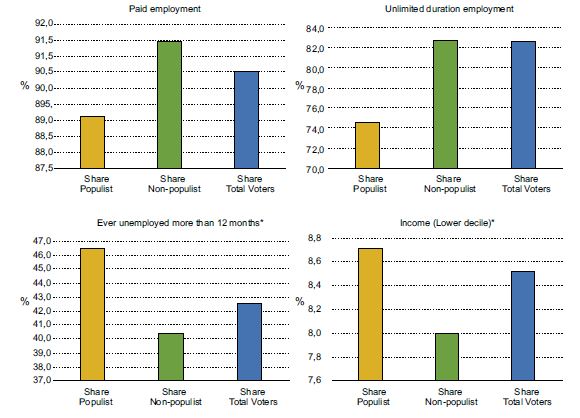
Source: Authors’ elaboration on ESS data. Note: asteriscs highlights those variables in which a statisticallysignificant difference of at least 0.05 has been registered
Figure 2 Socio-economic characteristics of total, populist and non-populist voters: having a paid employment, having a fixed-term employment contract, being unemployed for more than one year and income level
Data outline a clear picture showing how, on average, populist voters are in a worse socioeconomic position compared to non-populist ones. Populist voters, in fact, not only have an employment in a lower share of cases, but they are also less likely than non-populist ones to have a fixed-term contract. Conversely, populist voters show higher rates of long-term unemployment than non-populist ones. In addition, coherently with this picture, populist voters find themselves in the lower decile of the income ladder in a higher share of cases.
Table 5 reports the data concerning the third dimension considered, namely social values. Within this dimension, we considered the following variables: the share of voters that declare to belong to a religion, the share of voters that think that gays and lesbian should be free to live as they wish, voters’ average answer to the question enquiring whether country’s cultural life undermined or enriched by immigrants, voters’ average answer to the question enquiring whether it is important that people are treated equally and have equal opportunities, and voters’ average answer to the question enquiring whether it is important to care for nature and environment.
Table 5 Social values characteristics of total, populist and non-populist voters

Source: Authors’ elaboration on ESS data. Note: asteriscs highlights those variables in which a statisticallysignificant difference of at least 0.05 has been registered
The data show how populist voters tend to pertain to a religious denomination in a higher share of cases than non-populist ones, 61.1% against 58.2%. At the same time, populist voters exhibit a less tolerant attitude toward those groups of citizens that do not correspond to their traditional views. The share of populist voters that agree or strongly agree that gays and lesbians should be free to live life as they wish account for 64.23%, roughly ten percentage points below total and non-populist voters. Less pronounced but still significantly, populist voters tend to agree on average less than total and non-populist voters about the fact that the country’s cultural life is enriched by immigrants. Confirming this kind of attitude, on average, more than non-populist voters, they disagree about the importance that people are treated equally and have equal opportunities. Lastly, compared with non-populist voters, populist ones show, on average, a less pronounced interest in the care of nature and the environment.
Moving to political characteristics, firstly, it is interesting to note that populist voters are on average more oriented toward the right side of the political spectrum. In fact, on a scale that goes from 0 (extreme left) to 10 (extreme right), populist voters register an average value of 5.9, while non-populist voters an average value of 4.89.
Figure 3 reports the other data concerning voters’ political characteristics: the level of interest in politics, the ability to take an active role in political groups, and the involvement in trade unions or similar organizations.
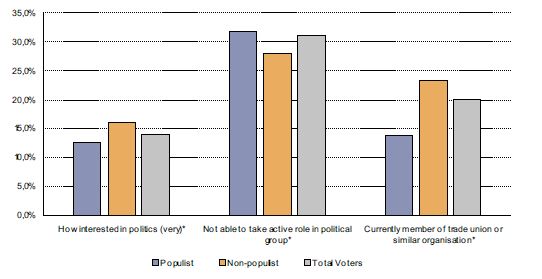
Source: Authors’ elaboration on ESS data. Note: asteriscs highlights those variables in which a statisticallysignificant difference of at least 0.05 has been registered.
Figure 3 Political characteristics of total, populist and non-populist voter
Data show how, on average, populist voters result to be less politically active than non-populist ones. On the one hand, they show less interest in politics and, on the other hand, they are (or used to be) members of trade unions or similar organizations in a lower share of cases. In addition, and probably explaining at least partially their less active attitude, populist voters feel unable to take an active role in political groups in a higher share of cases than non-populist voters.
Figure 4 presents the data concerning the perceptions of total, populist and non-populist voters. In particular, data refers to the perception about whether governments take into account the interests of all citizens, and about whether decisions in one’s own country’s politics are transparent.
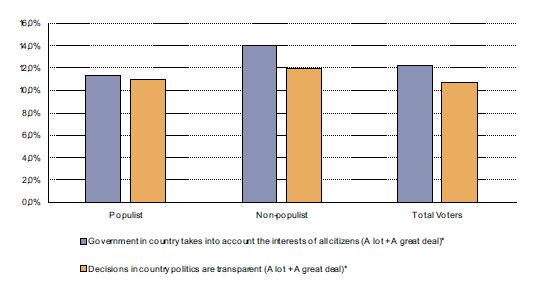
Source: Authors’ elaboration on ESS data. Note: asteriscs highlights those variables in which a statisticallysignificant difference of at least 0.05 has been registered.
Figure 4 Perception characteristics of total, populist and non-populist voters
As can be seen from the figure, in both cases populist voters are more pessimistic. In fact, they perceive that governments actually take into account all citizens’ interests and that political decisions are transparent in a significantly lower share of cases than non-populist voters.
Lastly, Table 6 reports the data concerning trust characteristics of total, populist and non-populist voters, specifically: trust in the country’s parliament, trust in the legal system, trust in politicians, trust in political parties, and trust in the European Parliament.
Table 6 Trust characteristics of total, populist and non-populist voters

Source: Authors’ elaboration on ESS data.Note: asteriscs highlights those variables in which a statisticallysignificant difference of at least 0.05 has been registered.
Data demonstrate that there are significant differences between populist and non-populist voters in the levels of trust of all the subjects considered, with populist voters manifesting lower levels of trust.
Discussion and Conclusions
The populist upsurge that, in the last decade, affected most democratic countries around the world has become a central topic in the recent sociological and political academic debate.
The literature mostly centered around the definition of the populist phenomenon (McDonnell & Cabrera, 2019; Mudde & Rovira Kaltwasser, 2013, 2017), on how it affects public opinion (Akkerman et al., 2014), parties (Pauwels, 2011), policymaking (Albertazzi & Mueller, 2013), and the theoretical and empirical analysis of its consequences on democracy and democratic quality (Archibugi & Cellini, 2018; Mudde & Rovira Kaltwasser, 2012).
On the contrary, the assessment of populist voters and their identities remained less investigated (Pauwels, 2014; Rooduijn, 2018). Furthermore, the few studies undertaken on such an issue did not reach homogenous conclusions, and in particular, Rooduijn (2018) concludes that “the populist voter does not exist” (p. 15).
To bridge the gap in the literature, the present paper traced a profile of populist voters, considering the voters of populist parties in 27 European countries, identifying their common characteristics, and assessing the presence of identity traits able to explain populist support.
Our analysis demonstrates that when comparing them to non-populist voters, populist voters show common characteristics and identities, significantly differentiate them in several characteristics. Populists are predominantly males, with an average age of 52 years. They have on average a lower number of children and they show a significantly lower level of education.
The analysis also shows that populist voters, on average, are in a worse socioeconomic position than non-populist ones. In particular, they are less employed and experience long-term unemployment in a higher number of cases. Furthermore, populist voters are more likely than non-populist ones to be part of the lower decile of the income ladder.
At the same time, populist voters tend to be part of religious belonging in a higher number of cases than non-populist ones, and they also exhibit a less tolerant attitude toward those groups of citizens that do not correspond to their traditional view. Also, they show a less pronounced interest in the care of nature and the environment.
Moving to political characteristics, more than non-populists, populists tend to be oriented toward the right side of the political spectrum. Also, they show less interest in politics, they tend to not be part of trade unions or similar organizations, and they feel to not be able to take an active role in political groups.
Lastly, populist voters systematically show a lower level of trust toward national and European political institutions than non-populists voters.
Even if mainly in descriptive terms, the present paper succeeds in tracing a profile of populist voters, highlighting the characteristics that significantly differ between those who do not vote and those who support a populist party.
Data, therefore, in principle, seem to confirm the presence of common characteristics identifying populist supporters. However, the analysis also shown that the differences between populist and non-populist voters, even if statistically significant, are quite modest for most of the characteristics considered. This seems to suggest that the use of the concept of populism could be not effective in distinguishing populism as a political movement with its own transnational characteristics. In other words, while the analysis shows how populist voters actually share some common characteristics and that such characteristics differenciate them from non-populist voters in a statistically significant way, the fact that the differences recorded are very small in most cases seems to highlight how populism have little effectiveness as an analytical concept for processes of political crisis. This is reinforced by the consideration that the vast majority of populist parties present in our sample pertain to the right of the far-right side of the political spectrum and, therefore, the movement of political opinion that the data highlight could be that of far right vorets rather that that of populist ones. These results seem to confirm the claims of Rooduijn (2018) according to which “populist voter does not exist” (p. 15).
The present analysis, however, being mainly descriptive, does not allow to reach a definitive conclution about the existence of common characteristics differenciating populist and non-populist voters. For this reason, future studies should take a step forward by providing an inferential assessment of such characteristics by looking at how they interact and to what extent they are useful to describe the populist vote and the populist phenomenon, and to understand to what extent populism could be a valid concept to assess a movement of political opinion both nationally and transnationally.














